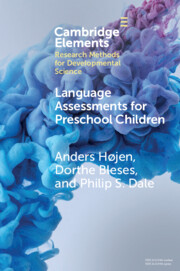Element contents
Language Assessments for Preschool Children
Published online by Cambridge University Press: 14 July 2022
Summary
Keywords
- Type
- Element
- Information
- Online ISBN: 9781108924399Publisher: Cambridge University PressPrint publication: 04 August 2022
References
- 5
- Cited by



